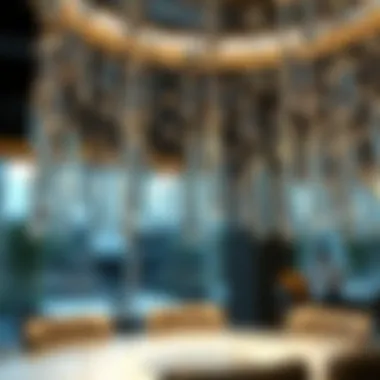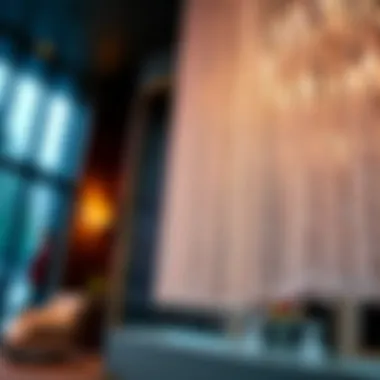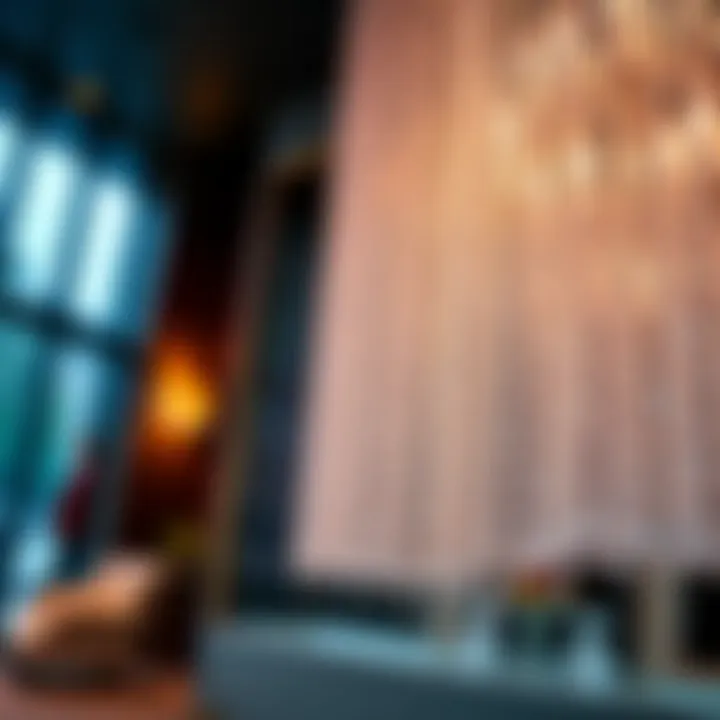Crystal Strands: Elevating Modern Decorative Design


Intro
Crystal strands, often viewed as mere decorative embellishments, quietly carry a rich history and profound significance in modern design. From the opulent chandeliers of palatial estates to the glimmering accents in contemporary interior spaces, these delicate filaments transform environments, casting ethereal reflections and adding layers of sophistication. This article digs deeper into how crystal strands not only serve aesthetic purposes but also bridge the gap between tradition and modernity in design.
As we journey through various aspects of their incorporation into contemporary decoration, we will highlight their multifaceted roles and practical applications, a must-read for designers, stylists, and anyone keen on elevating their decor.
Historical Context of Crystal Strands
Understanding the historical role of crystal strands sets a solid foundation for appreciating their modern applications. Originating from ancient traditions, crystals have long been considered symbols of light, purity, and beauty. In the Renaissance, for example, crystal chandeliers became status symbols among the elite, featuring in grandiose ballrooms and expansive dining halls.
"The delicate shimmer of crystal has enchanted generations, demonstrating a range of beauty that reflects both light and culture."
In today's context, although the lavish use of crystals has evolved, their place in design remains strong, having transitioned into more accessible forms suitable for a variety of settings.
Contemporary Applications in Interior Design
Crystal strands now play versatile roles in enhancing interiors. From homes to boutiques, their applications are diverse:
- Lighting Design: Chandeliers and pendant lights often incorporate crystal strands to radiate a warm glow, enhancing ambiance.
- Accent Decor: Crystal strands adorn everything from curtains to mirrors, ingeniously catching the eye while maintaining a spirit of elegance.
- Furniture Pieces: Stylish tables and cabinets often feature crystal details that add a touch of glam, seamlessly blending functionality with aesthetic appeal.
Incorporating these elements can make spaces feel more inviting and luxurious without overwhelming the senses.
Tips for Incorporating Crystal Strands
Getting the balance right is crucial when using crystal strands in your designs. Here are a few tips:
- Identify a Focal Point: Whether it’s a light fixture or a piece of artwork, using crystal strands as a highlight can draw attention and create visual interest.
- Mix Textures: Combine crystal with natural materials like wood or stone to achieve a layered look that feels both modern and timeless.
- Choose Your Setting Wisely: Analyze the space; too many crystal strands can overwhelm smaller rooms. Opt for simplicity in tight spaces and go bold in larger areas.
By following these considerations, one can integrate crystal strands into modern designs effectively and stylishly.
Epilogue
In the final analysis, crystal strands hold a revered place in the landscape of modern decoration. Their journey from opulent pasts to contemporary versatility underscores the dynamic interplay between tradition and innovation. Whether you’re a designer working on a chic new project or a homeowner looking to elevate your living space, understanding how to wield the aesthetic power of crystal strands can lead to inspiring and impactful designs.
For more on the decorative applications of crystal strands, check out Britannica and Wikipedia.
Explore how these elegant elements can articulate a refined narrative in your decor journey.
Understanding Crystal Strands
In the realm of modern decor, crystal strands play a pivotal role, intertwining elegance and functionality. They are not merely decorative elements; they embody an enduring aesthetic quality and versatility across various applications. By grasping the significance of these shimmering pieces, one can appreciate their contribution to creating environments that resonate with light and sophistication.
Definition and Composition
Crystal strands consist of individual crystals linked together, forming a chain that reflects light in mesmerizing ways. The composition varies based on the type of crystal used, be it natural or artificial. Natural crystals are gemstones shaped by nature over thousands of years, while artificial crystals are often crafted from glass or polymers that mimic their natural counterparts. This distinction not only affects aesthetics but also evokes differing emotional and cultural associations. The choice of materials thus becomes crucial in defining the atmosphere of a space. A well-formed crystal strand can bring a touch of luxury to a room, transforming an ordinary area into something truly spectacular.
Types of Crystals Used
Natural Crystals
Natural crystals, such as quartz or amethyst, bring a distinct connection to the earth. Their beauty lies in unique formations and colors. Many enthusiasts believe these crystals carry specific energies or properties, which can add a deeper layer of meaning to their aesthetic allure. For instance, amethyst is often associated with tranquility and clarity, while rose quartz embodies love and harmony. Such attributes make natural crystals not only delightful to behold but also emotionally resonant choices for decoration. However, their sourcing can be questionable, with concerns about ethical mining practices and environmental impact.
Artificial Crystals
On the flip side, artificial crystals offer a different set of advantages. They are often more affordable and can be designed in a plethora of colors and forms. Acrylic and glass are popular options that shine with brilliance, reflecting light almost as beautifully as their natural counterparts. These artificial options can also be molded into specific shapes, allowing for creative designs. The downside, however, lies in their potential lack of depth in character, which might be less appealing to purists who favor authentic materials. Ultimately, the choice between natural and artificial crystals depends on the desired aesthetic and the message one wishes to convey through decoration.
Craftsmanship and Artistry


The creation of crystal strands is as much about craftsmanship as it is about the materials themselves. Skilled artisans often painstakingly string together individual crystals, ensuring that each piece holds a harmonious balance of color, shape, and light. The artistry involved can elevate the strands beyond mere decoration into something truly expressive. Each piece reflects the artisans' unique vision and skilled hands, making them exceptional statements in any setting. When selecting crystal strands, understanding the craftsmanship ensures one appreciates the artistry that contributes to the decor's overall impact.
Historical Context
Understanding the historical context of crystal strands offers a foundational perspective on their evolution in modern decoration. This heading invites readers to explore how these stunning elements were originally perceived and utilized, which can enhance our appreciation of their contemporary applications. Analyzing the past provides not only insights into design aesthetics but also a deeper understanding of cultural significance over time.
Cultural Significance Through Time
Ancient Uses in Decoration
In ancient civilizations, crystals were not merely decorative objects; they were steeped in meaning and power. Historical records show that Egyptians understood the mystical properties of crystals. They would often adorn their tombs with lapis lazuli and turquoise, which were believed to offer protection in the afterlife. This emphasis on symbolism is a key characteristic of ancient uses in decoration, making crystal strands more than just eye-catching elements—they represent cultural heritage and spiritual beliefs that span centuries.
Moreover, such artifacts highlight the practical benefits of crystals. For instance, their ability to reflect sunlight has historically been valued in regions where natural light was scarce. The shimmering effect not only uplifted spaces but also created a sense of warmth and comfort. However, sourcing and crafting these materials posed challenges. The labor-intensive processes involved in shaping and polishing natural crystals meant that they were often reserved for the elite or used in significant ceremonial contexts.
Symbolism in Various Cultures
Diving deeper into symbolism reveals how crystal strands have been integral to various belief systems around the world. In many cultures, different crystals are associated with specific energies or emotions. For instance, amethyst is thought to promote tranquility and balance. The significance of these beliefs underscores why crystal strands continue to be a favored choice in modern decoration. Not only do they serve aesthetic purposes, but they also imbue spaces with a sense of purpose that resonates with the inhabitants.
A unique feature of this symbolism is how it can vary dramatically from one culture to another. In traditional Chinese practices, for instance, the use of jade is deeply revered. It’s not just a decorative piece but a symbol of virtue and beauty. This duality—both decorative and symbolic—captures the essence of why crystal strands remain relevant today. Still, it’s crucial to note that such associations can sometimes clash with contemporary decor sensibilities, requiring a careful balance when integrating these elements into modern settings.
Evolution in Design
As we’ve moved through the decades, the design of crystal strands has evolved dramatically. The shift from natural crystals to technologically enhanced varieties has opened new doors for creativity in interior design. Designers now play with variations in size, shape, and assembly, leading to innovative approaches in how crystal strands are perceived and used. This evolution showcases how humanity's changing tastes and technological advancements have continually reshaped the landscape of decoration, ultimately enriching modern interiors.
"The adaptability of crystal strands in design reflects broader trends in aesthetics and technology, shaping how we view and utilize these timeless materials in our spaces."
In summary, the historical context of crystal strands serves to illuminate their multifaceted role in modern decoration. From their ancient symbolic connection to contemporary design innovations, understanding this journey deepens our appreciation for what these exquisite elements can bring to both personal and professional environments.
Contemporary Applications
In today's world, crystal strands are not just decorative items but integral pieces that serve multiple purposes across various environments. Their application in modern decor has evolved significantly, leading to unique aesthetics and improved functionality in both personal and professional settings. Understanding these applications illuminates the balance between beauty and practicality, showcasing how crystal strands enhance our everyday spaces. They offer visual drama while being versatile and simple to integrate, making them a favorite choice among designers, stylists, and enthusiasts.
Interior Decoration
Residential Spaces
When it comes to residential spaces, the inclusion of crystal strands can transform a mundane area into something spectacular. They are often employed as eye-catching elements in rooms, adding a touch of glamour that elevates the overall ambiance. One key characteristic of residential spaces is that they tend to reflect personal taste, and crystal strands allow for customization to fit a wide range of styles—from modern minimalism to traditional elegance.
A unique feature of these strands is their ability to play with light, creating reflections and refracted colors that can manipulate the mood of a room. This can make a small space feel bigger or a dark room feel lighter. However, it’s important to note that while they offer charm, their installation can be a bit tricky, often requiring an understanding of the best mounting options to avoid cluttered looks. Generally speaking, homes with high ceilings benefit greatly as the strands can drape beautifully in ways that flatter the space.
Commercial Environments
In commercial environments, the use of crystal strands takes on a more strategic role. They often serve as focal points in lobbies or reception areas, helping to establish a brand’s identity and impress clients from the moment they walk in. The characteristic of commercial environments is their multifunctionality; spaces are designed not just for aesthetics but to facilitate interactions and workflows.
The shimmering quality of crystal strands can add a high-end feel without a need for an excessive budget. For instance, they might be used in office spaces to create a refreshing atmosphere, promoting creativity and collaboration among employees. However, unlike residential applications, the scale and positioning in commercial settings are critical, as poorly placed strands can clutter a professional space rather than enhance its sophistication.
Event Decoration
Weddings
Crystal strands in weddings often signify elegance and romance. They are commonly found in centerpieces, backdrops, and floral arrangements, contributing to the dreamlike atmosphere many couples aspire to create on their special day. A fundamental aspect of weddings is the desire to personalize each detail, and the versatility of crystal strands allows for a unique touch that reflects the couple’s style.
A unique feature here is the way these strands can blend seamlessly with other decorative elements, from soft lighting to vibrant florals, providing a cohesive look. However, they can also lead to additional costs and labor if not planned carefully, as intricate arrangements require skill to avoid overwhelming the space or the eye, stressing the importance of balance in decor.
Corporate Events
For corporate events, crystal strands serve not only decorative purposes but also strategic branding elements. They are used to create mesmerizing backdrops for important presentations, enhancing the professional atmosphere while still being visually appealing. A standout characteristic of corporate events is the goal of leaving a lasting impression on attendees, and crystal strands play into this by creating a sparkling environment that can elevate the company’s image.


However, the challenge lies in using them to reinforce the brand's message without appearing overly extravagant. Their placement and brightness should align with the event's overall tone. If executed correctly, they can spotlight achievements or key themes of the event, but poor use can detract from the intended professionalism.
Overall, the applications of crystal strands in modern decoration highlight their diverse utility, giving spaces a touch of unique character while appealing to both personal and corporate aesthetics.
Aesthetic Impact of Crystal Strands
When contemplating the decorative arts, few elements evoke the same level of intrigue and sophistication as crystal strands. Integrating these elements into modern spaces offers benefits that go beyond mere visual appeal. Crystal strands have a unique capacity to transform ordinary environments, creating enchanting atmospheres that captivate the senses. This section delves into the aesthetic impact of crystal strands, highlighting their effects on light and ambiance and exploring the rich variations in color and texture they offer.
Light Reflection and Ambiance
Crystal strands serve as exceptional light reflectors, creating a dynamic interplay between illumination and shadow. As sunlight or artificial light hits these strands, it scatters and refracts, generating a sparkly halo effect. This shimmering quality can soften harsh lighting, making a space feel warmer and more inviting. In dim settings, such as a cozy restaurant or an intimate salon, the scattered light can imbue a sense of romance or calm.
- Key Effects:
- Enhancement of Natural Light: Crystal strands can significantly amplify natural light, making even smaller rooms seem larger and airier.
- Mood Enhancement: The reflective surfaces can affect one’s emotional state; different intensities and angles of light can evoke various moods.
“The way light dances through crystal strands can change the very character of a room.”
Additionally, crystal strands can act as focal points that draw the eye, guiding viewers toward particular aspects of the decor. Whether suspended from a ceiling or woven into fabrics, they provide a narrative element that invites exploration.
Color and Texture Variations
The beauty of crystal strands extends far beyond their reflective qualities; they also come in a vast array of colors and textures that can enhance a space’s design. From subtle pastels to bold jewel tones, the colors of the crystals can complement or contrast with the existing palette of a room. Darker crystals, like smoky quartz, can create a moody elegance, while light, airy crystals can contribute to a fresh and breezy aesthetic.
- Considerations for Use:
- Contrast and Harmony: Designers often play with contrasting colors to create visual tension or opt for harmonious shades that promote unity in decor.
- Textures: The variations in texture—from smooth, polished surfaces to jagged, raw edges—add layers of depth and tactile interest.
In choosing crystal strands, attention to color and texture can elevate not just the structure of design elements but also allow for a personalized touch that reflects the inhabitant’s style.
Practical Considerations
When integrating crystal strands into modern decor, it’s important to consider the practical aspects to ensure optimal results. These considerations can significantly influence not only the aesthetic appeal of a space but also its functionality. Addressing installation techniques and maintenance provides a solid foundation for enjoying the beauty of crystal strands without headaches down the line.
Installation Techniques
Mounting Options
Choosing the right mounting option is one of the first steps when working with crystal strands. There are several ways to hang or attach these strands, each with its own merits.
Key characteristics of mounting options include:
- Versatility: The way strands are mounted can vary from wall fixtures to chandeliers and right down to simple curtain rods. This flexibility means crystal strands can fit into various design schemes, making them a popular choice for both residential and commercial spaces.
- Aesthetic Appeal: A well-chosen mounting technique can enhance the elegance of the crystal strands, allowing them to catch light and sparkle brilliantly.
For instance, ceiling-mounted options are often well-suited for dining areas where light reflection creates a romantic ambiance. However, one must be cautious; improper installation could lead to hazards if the strands fall. Therefore, taking time to decide on the correct method is crucial.
Considerations for Different Spaces
Different environments call for tailored approaches to crystal strand installation. A bustling commercial area will have unique demands compared to a serene home setting.
Key attributes include:
- Space Size: In larger areas, longer strands or multiple groupings can create a stunning focal point. In contrast, smaller spaces might benefit from more delicate arrangements to avoid overwhelming the area.
- Lighting Conditions: In spaces with ample natural light, specific types of crystal strands can shine without needing additional fixtures, while dim-lit areas may call for larger, more reflective pieces to enhance the light.
Moreover, consideration of the space's purpose is essential. For example, in a children's playroom, robustness and safety should drive the choice of installation. If fragile strands mean potential danger, then it's best to steer clear of them altogether.
Maintenance and Care


Keeping crystal strands in tip-top shape requires consistent care. These delicate materials, while stunning, can gather dust and dull over time. Here are some vital points for proper maintenance:
- Regular Dusting: Gentle dusting with a soft, dry cloth or a microfiber duster helps keep each strand sparkling. Avoiding harsh cleaning agents is essential as they can damage the surface.
- Cleaning With Care: For deeper cleaning, a mild soapy water solution can be effective. However, ensure that crystals are properly dried afterwards to prevent water spots.
Overall, routine maintenance guarantees that crystal strands remain a highlight in any decorative arrangement. By taking practical considerations into account, one can seamlessly integrate these decorative elements into a variety of settings, maximizing their visual and functional benefits.
Sustainability and Ethical Sourcing
In today's world, where awareness of environmental issues grows by the minute, the role of sustainability in design cannot be overstated. When it comes to crystal strands, the conversation shifts significantly towards ethical sourcing and sustainable practices in their creation. As designers and stylists, it is imperative to think critically about the materials we integrate into our work, ensuring they contribute positively to the environment rather than causing harm.
By incorporating sustainable practices in sourcing crystals, we can minimize the ecological footprint. This can involve choosing crystals harvested through responsible mining techniques or opting for synthetic alternatives that yield similar aesthetic results without the associated environmental degradation. Furthermore, supporting companies that prioritize sustainability creates a ripple effect, encouraging a shift in industry standards.
Eco-Friendly Alternatives
With the rise in demand for eco-conscious design, several alternatives to traditionally mined crystals are gaining popularity. Here are a few notable options:
- Recycled Glass Crystals: Made from upcycled materials, these crystals provide a similar visual appeal while reducing waste and energy consumption associated with new material production.
- Lab-Grown Crystals: These are engineered in controlled environments, minimizing the impact on natural habitats. They can be created to match the properties of natural crystals while ensuring that no ecosystems are disrupted.
- Natural Stone Variants: Stones like agate or quartz can serve as beautiful options, providing unique textures and colors without the intensive mining process.
These alternatives not only align with a sustainable ethos but can also be cost-effective, offering high quality at a lower environmental cost.
Impact of Mining on Ecologies
The impact of mining operations on local ecologies cannot be ignored. Extraction processes often involve:
- Habitat Destruction: Clearing land for mining activities destroys natural environments that wildlife depends on, leading to biodiversity loss.
- Water Pollution: Mining can lead to the contamination of local water sources, adversely affecting both ecosystems and communities reliant on those waters for their livelihood.
- Soil Erosion: Deforestation and land disturbance increase soil erosion, which can result in loss of fertile land and increased sedimentation in waterways.
Understanding these impacts is crucial for anyone in the decorative arts field. The choices made in material sourcing can either contribute to the preservation of the environment or lead to extensive ecological damage. As professionals, advocating for environmentally responsible practices not only enhances our designs but safeguards our planet for future generations.
Future Trends in Crystal Decoration
The world of decoration is always evolving, and the integration of crystal strands is no exception. Understanding the future trends in crystal decoration is not merely about keeping pace with style; it's about anticipating shifts in consumer preferences and the innovative approaches that artists and designers embrace. Crystal strands have been a staple in aesthetics for ages, but as society becomes more environmentally conscious and technology advances, how these strands are used continues to transform. This section will dive into what lies ahead in this enchanting realm.
Innovative Uses in Design
Today’s designers are pushing the envelope on how crystal strands can enliven spaces. Rather than just hanging as pendant lights or draping from ceilings, they are finding fresh avenues for their use. For instance, some creative minds are embedding crystals in wall art or incorporating them into architectural elements, injecting glamour into structural designs. The versatility of crystal strands allows them to seamlessly transition into unexpected roles, such as:
- Furniture Embellishment: Designers are opting to enhance tables and chairs with crystals that reflect light in captivating ways, adding a touch of luxury while maintaining function.
- Textile Integration: An emerging trend involves weaving crystal strands into fabrics, creating garments and drapes that showcase glimmering accents. Imagine a curtain where each strand catches the light, transforming the ambiance of a room.
- Interactive Installations: New trends are introducing the use of crystal strands in installations that engage viewers. These pieces often respond to environmental stimuli, creating a dynamic experience.
This evolution not only enhances aesthetic value but also sparks conversations around the design choices being made in our environments. As designers explore unique uses, they invite the audience to rethink what decoration can truly be.
Technological Advancements
The intersection of technology and decoration has opened a treasure trove of possibilities for the future of crystal strands. With the advent of 3D printing and advanced lighting solutions, the fabrication and application of crystals are becoming more sophisticated. Here are some noteworthy advancements:
- 3D Crystal Printing: The rise of 3D printing has allowed creators to design custom crystal shapes and patterns that were once limited by traditional methods. This means that designers can realize their unique visions with unprecedented precision and detail.
- Smart Lighting Integration: The integration of crystals with smart lighting technology brings an added layer of interaction to the surface. Crystals can be paired with smart bulbs that change colors, altering the mood of a space instantly and providing spontaneous displays.
- Sustainability Through Technology: Advances in manufacturing are also pointing towards more sustainable approaches. Techniques that minimize waste and harness energy efficiency are coming to the forefront. Crystal innovations would likely benefit from these advancements, thus aligning with contemporary consumer values on sustainability.
"Incorporating technology with traditional elements like crystals can create a marriage of elegance and innovation, leading to truly unique designs that speak to modern sensibilities."
The trajectory of crystal decoration is bright and infused with creativity. As crystal strands find new roles and meld with technology, their presence in design goes beyond mere decor; they become narratives of innovation and style. As we move forward, it will be crucial for designers and enthusiasts alike to stay abreast of these trends, embracing the potential that crystal strands hold in shaping our spaces.
Ending
In summing up the intricate tapestry that crystal strands weave in modern decoration, it's clear these elements are more than just decorative tools. They possess the ability to transform spaces dramatically, marrying beauty with function. Crystal strands catch light in ways that create mesmerizing atmospheres, making them not just visually appealing but also practical in enhancing the mood of a room. Additionally, their versatility means they can be used in a variety of environments, from cozy personal sanctuaries to bustling corporate settings.
Summary of Key Points
- Versatility in Design: Crystal strands can enhance diverse interiors, whether residential or commercial.
- Historical Significance: Their use through ages highlights rich cultural heritage and craftsmanship.
- Aesthetic Enhancement: These strands not only add beauty but also manipulate light, enhancing ambiance effectively.
- Contemporary Relevance: In today’s design world, they symbolize luxury, sophistication, and creativity.
Final Thoughts on Crystal Strands
As we reflect on the importance of crystal strands in the realm of design, it becomes evident that they are not merely aesthetic accessories. They are significant in shaping experiences within a space. Designers, stylists, and fashion students should ponder the deeper impact these elements have beyond just visuals. Their ability to captivate, influence mood, and create harmony is a testament to their value in both personal and professional environments. As trends evolve, the artistry behind crystal strands will likely continue to captivate the imagination, driving innovation and inspiring future generations of creatives.
"In the world of decoration, crystal strands are the unsung heroes that link history, craftsmanship, and modern flair, proving that what glitters often holds depth and story."
For further insights into the world of crystal decoration, consider exploring resources like Encyclopedia Britannica or Wikipedia.





